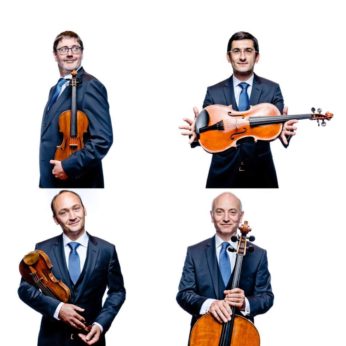Composer: Mieczyslaw Weinberg (b. 1919 - d. 1996)
Performance date: 28/06/2022
Venue: St. Brendan’s Church
Composition Year: 1945
Duration: 00:31:49
Recording Engineer: Simon Cullen, Ergodos
Instrumentation: 2vn, va, vc
Instrumentation Category:String Quartet
Artists:
Quatuor Danel (Marc Danel, Gilles Millet [violins], Vlad Bogdanas [viola], Yovan Markovitch [cello] -
[quartet]

Mieczysław Weinberg [1919-1996]
Quartet No.4 in E flat major Op.20 [1945]
1. Allegro commodo
2. Moderato assai
3. Largo marciale
4. Allegro moderato
Strange though it may seem, the War years from 1943 were good to Weinberg. On Shostakovich’s initiative he and his young wife had been brought to Moscow, their daughter Victoria was born, his great friendship with Shostakovich had begun and he composed a series of major works including his Third, Fourth and Fifth Quartets as well as his Piano Trio, Piano Quintet, two duo sonatas, two song cycles and sets of children’s pieces for piano. His long association with Shostakovich was based on their playing four hands piano music, mostly reductions of their latest works. Although commentators have tried to label Weinberg as a student of Shostakovich (who was a dozen years older), it is clear they were close collaborators who influenced and inspired each other.
Weinberg wrote: Shostakovich helped me with many things, some of which I am not even aware of myself. It seems that he took steps to evoke sympathy towards my music. I considered myself to be a happy man, because I could show my works to the finest composer of the twentieth century. This was an honour that subconsciously, so it seems, activated my writing of music.
Weinberg’s Fourth Quartet brings together perhaps for the first time a classically balanced structure with his naturally passionate expression. The opening Allegro commodo theme is in extended sonata form with three surprisingly subdued ideas, the first in a lilting six-eight rhythm whose many returns give the movement its friendly character. This does not really prepare us for the fury of the toccata-like defiance of the Scherzo.
This is initially quite restrained though the rhythmic drive is implacable. If you are not completely carried away by the pulse, you will notice all his subtle variations, most especially in the strange other-worldly Trio featuring a muted viola and a fervently singing cello. The Funeral March that follows is completely devastating, announced by thunderous chords that could almost introduce a Beethoven symphony. Both Weinberg and Shostakovich wrote massive funeral marches lamenting the millions who died in the War; each of them in their own way spoke for humanity and terrible loss of life brought about by deranged dictators.
Weinberg’s Quartet finales have a fragility that is almost a stylistic signature, unlike Shostakovich who always seemed to know exactly where he wanted to go. This particular Finale opens clearly and gracefully, not unlike the mood of the opening movement. We are treated to a tapestry of colours but the texture seems to fragment and you wonder just where is this going? Gradually he fights his way back to the graceful opening idea and the close is another typical Weinberg idiom, a long fade interrupted by a sudden crescendo and a very firm last bar.
Francis Humphrys
Copyright © 2025 West Cork Music. All rights reserved.
Designed and developed by Matrix Internet